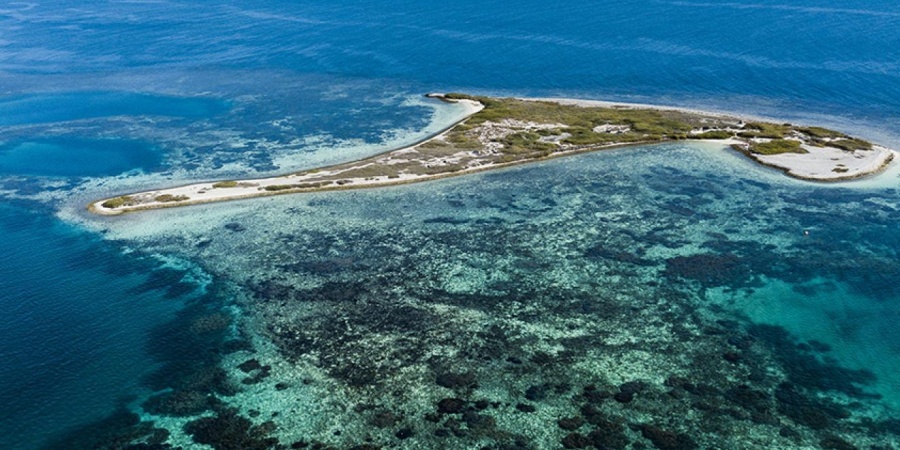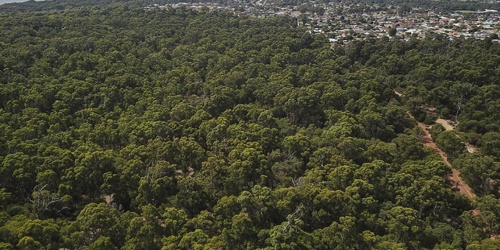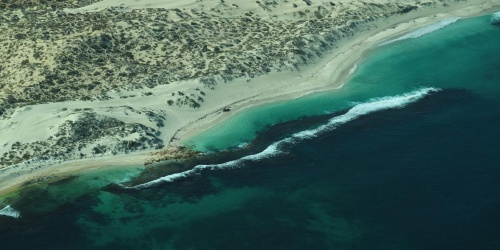
Beacon Island in the Houtman Abrolhos Islands National Park. Photo by Peter Nicholas/DBCA
issues licences to manage the appropriate commercial use of parks and reserves, including access and activities. This helps to ensure that the natural and cultural values of every park and reserve are protected for current and future generations to experience.
Commercial or tourism operators in the Houtman Abrolhos Islands National Park will need to obtain a commercial operations licence from DBCA. New licenses will be required from 1 July 2020.
More information on conducting commercial activities and license applications are available on the Commercial operations licencing page.
The national park's creation coincided with the 400-year anniversary of Dutch navigator Frederick de Houtman’s sighting of the Abrolhos. The park is vested with the Conservation and Parks Commission and managed by the Department of Biodiversity, Conservation and Attractions (DBCA).
It was announced on 6 October 2017 that the national park would be established. This announcement included a budget of $10 million over two years (2019 to 2021) for the sustainable tourism development of the Abrolhos Islands. This funding will be used to:
- develop visitor and management facilities to support sustainable tourism in the national park
- prepare a management plan
- undertake other planning for the sustainable development of tourism and other industries at the Abrolhos
The Houtman Abrolhos Islands National Park is the first national park to be created under the State Government’s Plan for Our Parks initiative, which aims to create at least five million hectares of new conservation estate over five years.
- Visit this website for regular updates on the development of the national park and opportunities to have your say.
- Visitor information about the Houtman Abrolhos Islands National Park is available on the Explore Parks website.
Park creation
The Houtman Abrolhos Islands National Park encompasses all unoccupied islands and parts of islands not occupied by commercial fishers and aquaculture operators. The national park extends to the high water mark with curtilages around the jetty at East Wallabi Island and the proposed jetty at Beacon Island. Airstrips on North, East Wallabi and Rat islands are within the national park.
The national park is managed in accordance with the Conservation and Land Management Act 1984 (CALM Act). This legislation provides for the use, protection and management of public lands and waters vested with the Conservation and Parks Commission and has functions relating to the conservation, protection and management of biodiversity.
The occupied lands leased by Abrolhos Body Corporate members and the waters surrounding the Abrolhos Islands continue to be vested with the Minister for Fisheries and managed by Department of Primary Industry and Regional Development (DPIRD).
Nature conservation values
The Abrolhos is an archipelago of 210 islands extending more than 100km from north to south and situated 60 to 80km off the mid-west coast of Western Australia. The national park covers 189 of these islands.
Geology
The islands are made of limestone under a layer of sand, cemented coral rubble and shingle. Some were originally low hills on the edge of Western Australia while others were formed more recently by either wind, waves and swell or by the erosion and deposition of sediments.
The basis of the island clusters is an ancient limestone reef platform that began forming layer upon layer from coral 120,000 to 130,000 years ago when sea levels were much lower than today. As sea levels rose, the coral grew upwards, gradually building the platform over thousands of years.
Today, the coral reef that perches atop these ancient platforms is recognised as the southernmost coral reef system in the Indian and Pacific oceans. The ancient reef platforms and the coral reef lying on top have been created by the Leeuwin Current flowing south from the tropics, bringing warm tropical waters laden with coral larvae that settle and grow, building coral reefs.
During the last ice age when sea levels were much lower than today, the islands became part of the mainland, and were separated again approximately 8000 years ago by rising sea levels. This enabled plants and animals to colonise the islands and evolve in isolation, giving rise to a unique suite of flora and fauna, some of which are found nowhere else on Earth. This high biodiversity also results from the islands’ location at the point where northern and southern regions cross over. This overlap accommodates an eclectic mix of both tropical and temperate species, reminiscent of the Galapagos Islands.
With the added benefit of being free of feral cats and foxes, the islands offer a safe haven for numerous species of fauna, many of which are of special conservation interest.
Bird life
The Abrolhos Islands form the largest and most species rich seabird breeding area in the eastern Indian Ocean. Most of the islands in the archipelago have bird nesting and breeding sites. In addition to seabirds, the islands are home to vulnerable and endangered shorebirds, and migratory waders including several critically endangered species - the curlew sandpiper, great knot, eastern curlew and bar-tailed godwit.
Mammals
The Australian sea lion is one of the rarest species of pinnipeds in the world, occurring only in Western Australia and southern Australia. The Abrolhos Islands mark the northernmost limit of their range. The islands are also home to important mammal fauna including the tammar wallaby (Macropus eugenii) and southern bush rat (Rattus fuscipes).
Reptiles
There are 25 reptile species across the various islands including the vulnerable dwarf bearded dragon.
Vegetation
Fragile coastal vegetation makes up most of the terrestrial flora. Surveys have recorded 201 native plant species including four priority species and several communities of special conservation interest including mangroves (Avicennia marina), saltbush flats and Atriplex cinerea dwarf shrubland.
Heritage values
Dutch navigator Frederik de Houtman was the first European to encounter the low-lying islands on 29 July 1619. He named them the Abrolhos Islands. Sailors of the 1600s used the Portuguese cry ‘Abrolhos’ (open your eyes) to warn of offshore reefs or other spiked obstructions in the sea. When Houtman narrowly missed being wrecked, he most likely wrote this as a caution in the empty space on his chart to warn other sailors of the dangers.
Wrecks
The rugged nature of the Abrolhos coastline is clearly demonstrated by the number of ships and boats that have been wrecked on the islands over time. These include several early Dutch sailing vessels en route to the Dutch East Indies (now Indonesia). The resulting shipwrecks created the earliest European archaeological sites in Australia. The Batavia (1629) wreck is located in the Wallabi Group and is well known for its horrific story of mutiny and subsequent massacre.
The ‘Batavia shipwrecks and survivor camps 1629’ is on Australia’s iconic National Heritage List, and has additional protection under the Commonwealth Environment Protection and Biodiversity Conservation Act 1999.
Survivors of the wreck of the Zeewijk (1727) wrecked on Half Moon Reef in the Pelsaert Group camped on Gun Island for nine months. They used timbers from the wreck to construct a small boat to sail to Batavia (now Jakarta).
Eighteen other historic wrecks have been discovered in Abrolhos waters. Another 31 wrecks remain undiscovered. Historic shipwrecks and associated land sites at the Abrolhos are protected under State and Commonwealth law. The Western Australian Museum is responsible for the management of all historic shipwrecks in WA under the Commonwealth's Underwater Cultural Heritage Act 2018, and the State’s Maritime Archaeology Act 1973.
Artefacts from Batavia, Zeewijk and other historic shipwrecks can be seen in the WA Museum of Geraldton, and the WA Shipwrecks Museum in Fremantle.
Commercial activities
The commercial extraction of guano (seabird excrement) for fertiliser began in 1847 and mining was conducted on several islands until 1946. Remnants of the industry including tramways, machinery, stone jetties, ruins and landscape modifications are still visible on some islands.
Commercial fishing also contributes to the heritage values of the Abrolhos. Commercial fishing for western rock lobster (Panulirus cygnus) commenced in the 1840s and became a well-established industry by the mid twentieth century. Now, the industry is Western Australia’s most valuable commercial fishery. The waters around the Abrolhos are an important lobster-breeding site.
Project Governance – Interagency Project Team (IPT)
To deliver sustainable tourism development of the Abrolhos Islands, DBCA is working collaboratively with State Government agencies and local government. A whole-of-Government planning process will develop the most appropriate management framework for the marine and terrestrial areas of the Abrolhos. In 2017, DPIRD and DBCA formed an interagency project team (IPT) to provide direction and advice to this process to ensure the effective delivery of the Government’s commitment. In 2019, the membership was expanded to agencies with legislative responsibilities or an interest in the management of the Abrolhos, including the Western Australian Museum, Mid West Development Commission, Tourism Western Australia, and the City of Greater Geraldton.
The IPT provides an opportunity for informal liaison between these groups, rather than a formal advisory or decision-making group. The role of the IPT is to:
- Provide input into the whole-of-government planning processes for the lands and waters of the Abrolhos
- Provide coordination between State Government agencies and local Government for the development of management plans for the land and waters of the Abrolhos, the development of visitor facilities in the Wallabi Group, to encourage new tourism investment and protect the natural and cultural heritage values of the Abrolhos.
- Provide a conduit between State Government agencies, local Government, and partners/key stakeholders, and ensure stakeholder and community consultation through communication and engagement opportunities in the planning processes.
- Ensure that decision making is based on sound science and information.
Houtman Abrolhos Islands Strategic Direction 2020-24
The Houtman Abrolhos Islands Strategic Direction 2020-24 has been prepared to communicate the State Government’s vision and goals for management of the Abrolhos Islands. The strategic plan considers constraints to sustainable use and development, and proposes initiatives to facilitate development opportunities. This document outlines collaborative inter-agency arrangements that maximise resource sharing and improve whole-of-government efficiency in management of the Abrolhos.
A copy of the Houtman Abrolhos Islands Strategic Direction 2020-24 is available for download at the bottom of this webpage.
Management plan
DBCA prepares management plans for parks and reserves in accordance with the Conservation and Land Management Act 1984 (CALM Act). This is done on behalf of the Conservation and Parks Commission and in consultation with the community and stakeholders. Management plans consider the natural, cultural, visitor use, community, economic and resource use values of the protected area. They also guide long-term management directions, by outlining objectives and strategies for a 10-year period.
The planning process for the Houtman Abrolhos Islands National Park involved:
- Stage 1. collection and analysis of background information about the national park values and management issues
- Stage 2. community and stakeholder consultation
- Stage 3. preparation of the draft management plan
- Stage 4. release of the draft management plan for public comment
- Stage 5. analysis of submissions received during the public comment period
- Stage 6. preparation and release of the final management plan
The Houtman Abrolhos Islands National Park draft management plan 2021 was released for public comment in mid-2021. Comments were analysed and the final plan was prepared, based on this feedback.
The Houtman Abrolhos Islands National Park management plan 97, 2022 was released by the Minister for Environment on 3 November 2022 (Stage 6). The final management plan and the summary of issues from public submissions to the draft management plan can be downloaded below.
Visitor master plan
The visitor master plan is a guiding document for tourism and visitor management for the national park. It will provide context and detail for inclusion in the management plan.
The visitor master plan provides:
- an overall vision for visitor and tourism management of the Abrolhos
- documented values and opportunities for recreation and tourism
- key directions for tourism and visitor management in each of the island groups
- guidelines for the development of individual visitor master plans for each of the island groups
- a coordinated approach to visitor management and tourism across Government and community, including DPIRD, Western Australian Museum, Tourism WA, Mid West Development Commission, City of Greater Geraldton, Abrolhos Bodies Corporates and the Western Australian community
Stakeholders, such as community interest groups, commercial operators, conservation groups and State Government departments, provided input to the plan. Workshops and discussions have provided valuable information to establish context and analysis of the islands for inclusion in the plan.
The visitor master plan will inform the management plan, will continue to be refined and remain a draft until the management plan is finalised.
Operations and management
The State Government requires a whole-of-government approach to management of the Abrolhos. While several government agencies have statutory responsibilities for management, the primary, day-to day management requirements will be delivered by DBCA (for the national park) and DPIRD (for the Abrolhos Body Corporate leasehold lands and all of the waters surrounding the Abrolhos ).
DBCA and DPIRD are working together to maximise the effectiveness and cost efficiency of operational activities at the Abrolhos, including through shared knowledge, expertise and resources.
DBCA’s management presence at the Abrolhos currently consists of two permanent staff, and a surplus DPIRD patrol vessel is currently being transferred to DBCA to facilitate management of the new national park. Operational works to date have focussed on visitor risk management, airstrip maintenance and Abrolhos painted button-quail recovery.
Visitor facilities
Significant infrastructure investment is planned to support sustainable tourism in the national park. This investment in tourism infrastructure focuses initially on East Wallabi and Beacon islands and will include the replacement of existing dilapidated facilities, managing risks to visitor safety and interpreting the natural and heritage values of these fascinating destinations. Also, following the collapse of the Rat Island shelter at the airstrip, a new shelter was built in August 2020.
The following infrastructure is planned to be completed mid-2021.
East Wallabi jetty
- Replacement of the existing jetty - to address issues of accessibility, jetty height, water depth and berthing space
East Wallabi tourist and airstrip facilities
- New shelters, toilets, paths and interpretation to improve visitor access, experience and safety
- A redesign of the airstrip precinct to better allow for passenger access and operational efficiency
Beacon Island tourist infrastructure
- A small craft (up to 12m) landing jetty and appropriate visitor facilities to interpret and protect the island’s natural and heritage values
National park operations base
- Accommodation, storage and management facilities for DBCA, DPIRD and other Government use, on East Wallabi Island
Commercial tour operator licensing
DBCA issues licences to manage the appropriate commercial use of parks and reserves, including access and activities. This helps to ensure that the natural and cultural values of every park and reserve are protected for current and future generations to experience.
Commercial or tourism operators in the Houtman Abrolhos Islands National Park will need to obtain a commercial operations licence from DBCA. New licenses will be required from 1 July 2020.
For more information on conducting commercial activities and license applications, please visit Commercial Operators Licencing.

